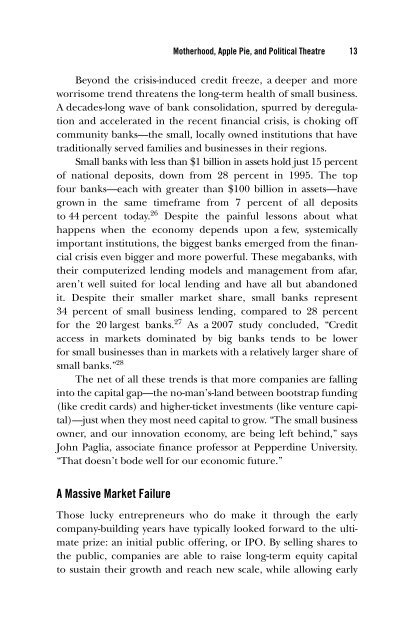3c hapter - Index of
3c hapter - Index of
3c hapter - Index of
You also want an ePaper? Increase the reach of your titles
YUMPU automatically turns print PDFs into web optimized ePapers that Google loves.
Motherhood, Apple Pie, and Political Theatre 13<br />
Beyond the crisis- induced credit freeze, a deeper and more<br />
worrisome trend threatens the long- term health <strong>of</strong> small business.<br />
A decades- long wave <strong>of</strong> bank consolidation, spurred by deregulation<br />
and accelerated in the recent fi nancial crisis, is choking <strong>of</strong>f<br />
community banks—the small, locally owned institutions that have<br />
traditionally served families and businesses in their regions.<br />
Small banks with less than $1 billion in assets hold just 15 percent<br />
<strong>of</strong> national deposits, down from 28 percent in 1995. The top<br />
four banks—each with greater than $100 billion in assets—have<br />
grown in the same timeframe from 7 percent <strong>of</strong> all deposits<br />
to 44 percent today. 26 Despite the painful lessons about what<br />
happens when the economy depends upon a few, systemically<br />
important institutions, the biggest banks emerged from the fi nancial<br />
crisis even bigger and more powerful. These megabanks, with<br />
their computerized lending models and management from afar,<br />
aren’t well suited for local lending and have all but abandoned<br />
it. Despite their smaller market share, small banks represent<br />
34 percent <strong>of</strong> small business lending, compared to 28 percent<br />
for the 20 largest banks. 27 As a 2007 study concluded, “Credit<br />
access in markets dominated by big banks tends to be lower<br />
for small businesses than in markets with a relatively larger share <strong>of</strong><br />
small banks.” 28<br />
The net <strong>of</strong> all these trends is that more companies are falling<br />
into the capital gap—the no-man’ s- land between bootstrap funding<br />
(like credit cards) and higher- ticket investments (like venture capital)—just<br />
when they most need capital to grow. “The small business<br />
owner, and our innovation economy, are being left behind,” says<br />
John Paglia, associate fi nance pr<strong>of</strong>essor at Pepperdine University.<br />
“That doesn’t bode well for our economic future.”<br />
A Massive Market Failure<br />
Those lucky entrepreneurs who do make it through the early<br />
company- building years have typically looked forward to the ultimate<br />
prize: an initial public <strong>of</strong>fering, or IPO. By selling shares to<br />
the public, companies are able to raise long- term equity capital<br />
to sustain their growth and reach new scale, while allowing early
















